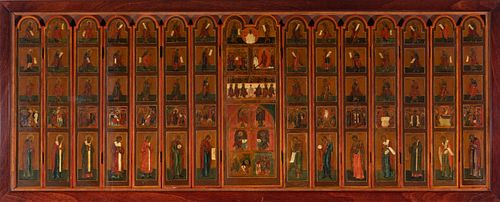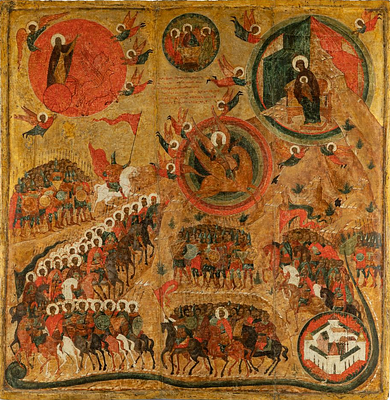Russian school, 18th-19th century. "Portable five-tiered iconostasis". Tempera, gold leaf on panel.
Lot 71
About Seller
Setdart Auction House
Carrer Aragó 346
Barcelona
Spain
Setdart Subastas was born in 2004 and is currently the first online art auction in Spain with solidity, prestige and reliability guaranteed by our more than 60,000 users. Setdart has a young, dynamic and enterprising team ready to successfully manage the purchase and sale of art works through custom...Read more
Estimate:
EUR€6,000 - EUR€8,000
$6,250 - $8,333.33
Absentee vs Live bid
Two ways to bid:
- Leave a max absentee bid and the platform will bid on your behalf up to your maximum bid during the live auction.
- Bid live during the auction and your bids will be submitted real-time to the auctioneer.
Bid Increments
| Price | Bid Increment |
|---|---|
| EUR€0 | EUR€10 |
| EUR€200 | EUR€25 |
| EUR€500 | EUR€50 |
| EUR€1,000 | EUR€100 |
| EUR€3,000 | EUR€200 |
| EUR€5,000 | EUR€500 |
| EUR€10,000 | EUR€1,000 |
| EUR€20,000 | EUR€2,000 |
| EUR€50,000 | EUR€5,000 |
About Auction
By Setdart Auction House
Sep 23, 2021
Set Reminder
2021-09-23 10:00:00
2021-09-23 10:00:00
America/New_York
Bidsquare
Bidsquare : RUSSIAN ICONS
https://www.bidsquare.com/auctions/setdart-auction-house/russian-icons-7431
Setdart Auction House sofia@setdart.com
Setdart Auction House sofia@setdart.com
- Lot Description
Russian school, 18th-19th century. "Portable five-tiered iconostasis". Tempera, gold leaf on panel. Measurements: 43 x 120 cm. 51 x 128 cm (frame). Iconostasis as a religious object is one of the most important phenomena of medieval Russian culture. Iconostases of the 15th-16th century can be divided into four types according to the number of levels, or rows, from two to five levels. They also reached their full development in the 16th century with five rows. Iconostases exist both for public use, in churches, and for domestic use, as in the present lot. In their structure they are practically the same as ecclesiastical iconostases, but with some slight changes that are linked above all to the convenience of use. The reading of any iconostasis starts from the bottom upwards. The lower level is called the local level. In the case of the lot of interest, it imitates the structure of an ecclesiastical iconostasis, since it has a central door, known as the 'sacred' door. It has no functional use, but serves to respect the structure. It is decorated with six miniatures of the annunciation, and below this scene are miniatures of the four evangelists. On either side of the door are depictions of the Virgin and John the Baptist, archangels Michael and Gabriel, and other local saints. Unlike the fixed iconostasis, this one lacks the south and north doors, which are located at both ends of the iconostasis. The second row is called the 'festive level'. This is where the important Gospel celebrations are located. It usually contains the images of the Crucifixion, Resurrection, Descent into Hell, The Passion of Christ, The Last Supper. In the case of this image, scenes with a Marian theme can be seen. The fourth row contains the Deesis level. This is the most important level of the whole iconostasis, from which its construction really begins. Deésis is Greek for prayer. In the centre of this level is always Jesus Christ, different versions are possible. In the case of the present iconostasis, the author opted for an unusual composition. In the central register of the iconostasis, just above the fictitious door, there is a triple representation of Christ in the form of the Last Supper, and above this miniature, there is the Crucifixion and the miniature of the Deesis in a single image, unlike the traditional structure, when the Virgin, Jesus Christ and St John the Baptist, the three protagonists of the scene, are represented in individual icons, in the form of a triptych. On the two sides of the third and fourth levels are miniatures of various saints, apostles and prophets. The iconostasis culminates with the fifth level, which belongs to the antediluvian patriarchs. These are the characters of the Old Testament, the ancestors of Christ, including the first humans, Adam, Eve and Abel. This iconostasis is a religious work of a very high level, both compositionally and chromatically, as well as iconographically.
- Shipping Info
-
In-house shipping available. Please inquire at admin@setdart.com.
-
- Buyer's Premium



 EUR
EUR CAD
CAD AUD
AUD GBP
GBP MXN
MXN HKD
HKD CNY
CNY MYR
MYR SEK
SEK SGD
SGD CHF
CHF THB
THB

















